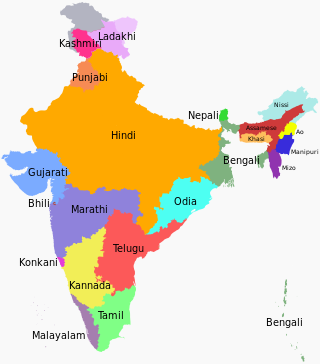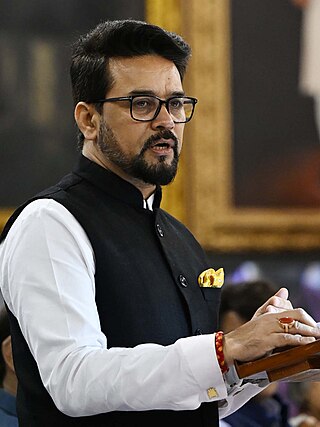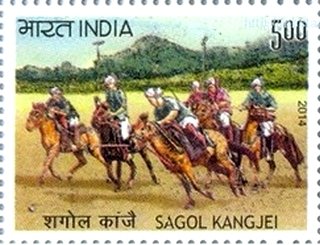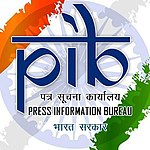
Languages spoken in the Republic of India belong to several language families, the major ones being the Indo-Aryan languages spoken by 78.05% of Indians and the Dravidian languages spoken by 19.64% of Indians; both families together are sometimes known as Indic languages. Languages spoken by the remaining 2.31% of the population belong to the Austroasiatic, Sino–Tibetan, Tai–Kadai, and a few other minor language families and isolates. According to the People's Linguistic Survey of India, India has the second highest number of languages (780), after Papua New Guinea (840). Ethnologue lists a lower number of 456.

There is no national language in the Republic of India. However, article 343(1) of the Indian constitution specifically mentions that "The official language of the Union shall be Hindi in Devanagari script. The form of numerals to be used for the official purposes of the Union shall be the international form of Indian numerals," while article 343(2) allowed for the continuation of English as an official language for another 15 years and 343(3) gave the parliament the power to provide for the use of English language after this period. The clause 3 of the Official Languages Act, 1963 allows for the continued use of English language for official purposes of the Union government and for parliamentary business. Hence Indian English and Modern Standard Hindi are the Official Languages of the Government of India.

Meitei, also known as Manipuri, is a Tibeto-Burman language of northeast India. It is the official language and the lingua franca of Manipur and one of the official languages of Assam. It is one of the constitutionally scheduled official languages of the Indian Republic. Meitei is the most widely-spoken Tibeto-Burman language of India and third most widely spoken language of northeast India after Assamese and Bengali. There are 1.76 million Meitei native speakers in India according to the 2011 census. Most of these, or 1.52 million, are found in the state of Manipur, where they represent majority of its population. There are smaller communities in neighbouring Indian states, such as Assam (168,000), Tripura (24,000), Nagaland (9,500), and elsewhere in the country (37,500). The language is also spoken by smaller groups in neighbouring Myanmar and Bangladesh.

The Meitei people, Meetei, Manipuri people is an ethnic group native to Manipur. They form the largest and dominant ethnic group of Manipur in Northeast India. They speak the Meitei language, one of the 22 official languages of the Indian Republic and the sole official language of Government of Manipur. The Meiteis primarily settled in the Imphal Valley region in modern-day Manipur, though a sizeable population has settled in the other Indian states of Assam, Tripura, Nagaland, Meghalaya, and Mizoram. There is also a notable presence of Meitei people in the neighbouring countries of Myanmar and Bangladesh. The Meitei ethnic group represents about 53% of Manipur's population.

The Meitei script, also known as the Kanglei script or the Kok Sam Lai script, after its first three letters is an abugida in the Brahmic scripts family used to write the Meitei language, the official language of Manipur, Assam and one of the 22 official languages of India. It is first known from engravings on 6th century CE coins and copper plate inscriptions. as verified by the various publications of the National Sahitya Akademi. It was used until the 18th century, when it was replaced by the Bengali alphabet. A few manuscripts survive. In the 20th century, the script was revived and is again being used. Beginning in 2021, the Government of Manipur began to use the Meitei alongside the Bengali-Assamese script, per the Manipur Official Language (Amendment) Act, 2021.
The Indian classical languages, or the Shastriya Bhasha or the Semmozhi, is an umbrella term for the languages of India having high antiquity, and valuable, original and distinct literary heritage. The Republic of India officially recognises six languages as the Classical languages of India. In 2004, the Government of India declared that languages that met certain strict criteria could be accorded the status of a "Classical Language" of India. It was instituted by the Ministry of Culture along with the Linguistic Experts' Committee. The committee was constituted by the Government of India to consider demands for the categorisation of languages as Classical languages.

Ministry of Information and Broadcasting is a ministerial level agency of the Government of India responsible for the formulation and administration of rules, regulations and laws in the areas of information, broadcasting, the press and the Cinema of India.
The Directorate of Advertising and Visual Publicity (DAVP) is the nodal agency of the Government of India for advertising by various Ministries and organisations of Government of India, including public sector undertakings and autonomous bodies.
The Indian Information Service (IIS) is the central civil service under Group A and Group B of the Central Civil Services of the executive branch of the Government of India.
The Bureau of Outreach and Communication (BOC), formed from the merger of Directorate of Advertising and Visual Publicity (DAVP) with two other departments, is the nodal agency of the Government of India for advertising by various Ministries and organisations of Government of India, including public sector undertakings and autonomous bodies.

Manipuri Language Day, is an annual celebration of the Manipuri (Meitei) language in India and Bangladesh 20 August. It is a of the day on which Manipuri was added to the Eighth Schedule to the Constitution of India, making it one of the official languages of India on 20 August 1992.

Meitei input methods are the methods that allow users of computers to input texts in the Meitei script, systematically for Meitei language.

The social movement of Meitei language to achieve the officially recognised status of the "Classical language of India" is advocated by various literary, political, social associations and organisations as well as notable individual personalities of Bangladesh, Myanmar, Northeast India.

The Meitei language movement, also known as the Manipuri language movement, is any linguistic movement undertaken by the literary, political and social associations as well as organisations, advocating for a change or development of Meitei language in various critical, discriminative and unfavorable circumstances and situations.

The social movement of Meitei language to attain linguistic purism is advocated by literary, political, social associations and organisations as well as notable individual personalities of Bangladesh, Myanmar and Northeast India.

The Nepali Language Movement was a political movement in the Republic of India advocating the recognition of the Nepali language as a language with official status in India. On 20 August 1992, the Lok Sabha passed a motion to add the Nepali language to the Eighth Schedule to the Constitution of India. According to an estimate in 2017, in India there about 40 million Nepali-language speaking Indians.

The Marjing Polo Statue is a colossal classical equestrian statue of a player of Sagol Kangjei, riding a Meitei horse, constructed at the Marjing Polo Complex, the sacred sports site dedicated to God Marjing, the ancient Meitei deity of polo and horses, in Heingang, Imphal East District, Kangleipak . It is the world's tallest statue of a polo player. It is built to commemorate the game of "modern polo" being originated from Kangleipak.
Marup is an Indian Meitei language newspaper, circulated mainly in the Northeast Indian state of Tripura. It started its publication works in the year 1969. It is published in Agartala. It is recognised by the Information and Cultural Department of the Government of Tripura.

Sagol Kangjei is a traditional Meitei ball sport played on horseback with a long-handled stick. The sport, also known as Manipuri polo, is a predecessor of modern international polo.











